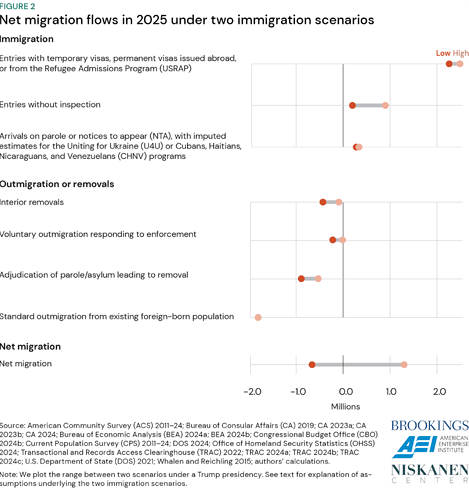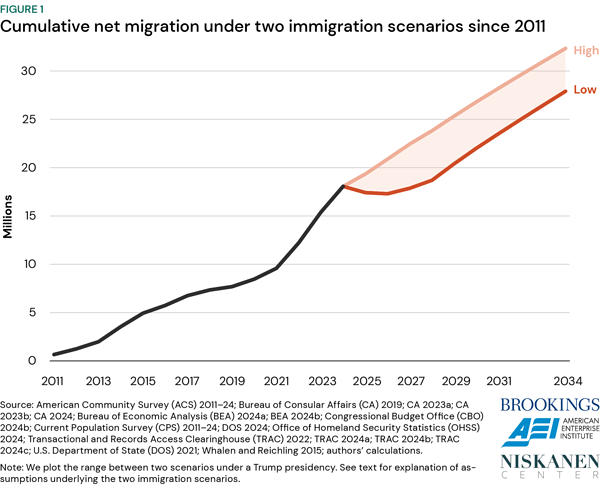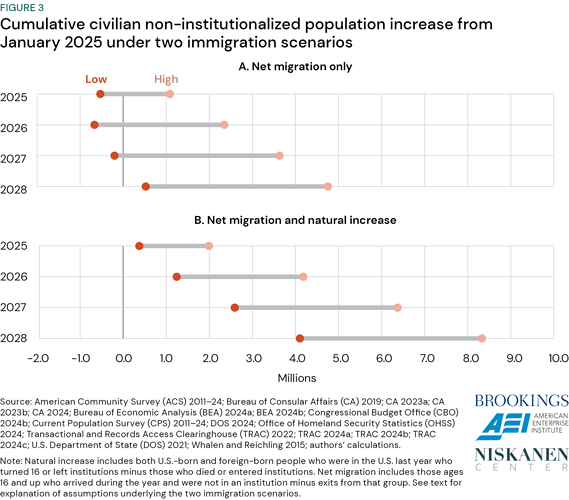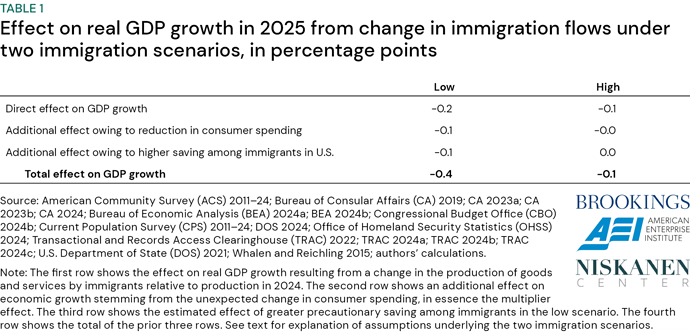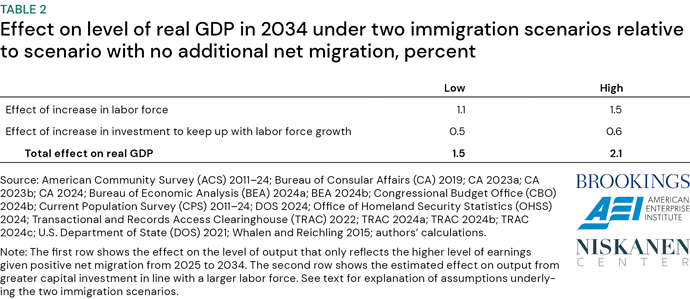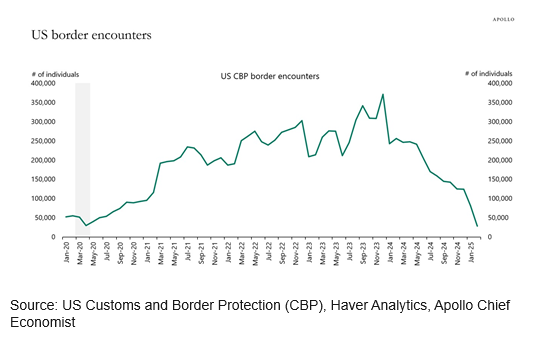Due to the Immigration flows being a significant contributor to labor market supply and chance labor force, is important to understand the effects the limitation on flows will bring to the US economy.
Immigration Policy Scenarios
These are immigration scenarios from Brookings
- High-Immigration Scenario:
- Assumes immigration levels close to those during Trump’s first term (2017–2019) and reflects a moderate enforcement approach.
- Net migration projected at +1.3 million in 2025, with cumulative net migration of 5.8 million over four years.
- More immigrants contribute to labor force growth, consumption, and economic output.
- Low-Immigration Scenario:
- Involves stricter policies, including reduced legal immigration and increased deportations.
- Net migration projected at -650,000 in 2025, with cumulative net migration of 630,000 over four years.
- Reflects significant disruptions, including outmigration exceeding inflows in the early years.
Economic Impacts
In the “low” scenario, the cumulative increase in the civilian non-institutionalized population over age 16 is 4 million people through 2028 versus 8 million in the “high” scenario.
- GDP Growth:
- Immigration contributes to labor force growth, driving productivity and output.
- High Scenario: Reduces 2025 GDP growth by 0.1 percentage points compared to 2024 due to slower immigrant-driven growth.
- Low Scenario: Reduces GDP growth by 0.4 percentage points due to a sharp contraction in the labor force and related output.
- Consumer Spending:
- Fewer immigrants lead to reduced aggregate demand, as immigrants tend to spend on housing, goods, and services.
- Businesses may cut production and investment in response, dampening economic momentum further.
- Inflationary Pressures:
- A reduced labor force could increase labor costs, raising prices for services like agriculture and caregiving.
- However, lower demand could suppress inflation for other goods, leading to modest net effects on inflation.
- Labor Market:
- Slower immigration leads to fewer workers, stalling labor force growth and potentially reducing monthly employment gains by 100,000 jobs in 2025 under the low scenario.
- Long-Term Effects:
- Over the decade, cumulative immigration contributes to a larger labor force, higher GDP, and greater capital investment under the high scenario.
- By 2034, GDP is projected to be 2.1% higher under the high scenario compared to a no-net-immigration baseline, versus 1.5% higher in the low scenario
Decline on Immigration could Weight in Labor Force Growth
Apollo’s Slok: "The chart below shows that there were almost zero border encounters in February 2025. The sharp decline in immigration in recent months will have very significant implications for nonfarm payrolls in March, April, and May because it could lower the population growth-consistent nonfarm payroll estimate to 60,000, down from as much as 200,000 in 2024.
“Put differently, the ongoing sharp decline in immigration will automatically result in a sharp decline in nonfarm payrolls over the coming months.”
https://x.com/neilksethi/status/1904130553063919682
Goldman Sachs Estimates Potential Impact from Lower Immigration is also moderate but still noticeable for 2025
- Immigration to the U.S. is projected to decline to about 750,000 people per year. This is below the elevated levels of the last three years but only slightly below the pre-pandemic average.
- The reduction in immigration would contribute 30–40 basis points less to potential GDP growth than in 2023–24, and just 5 basis points less than the pre-pandemic norm.
- The effect on the labor market is expected to be modest. With the labor market now more balanced, the slowing of immigration should reduce labor force growth without significantly driving up inflation or wages.
Assessment: Since 2024 real GDP growth was 2.8%, less immigration alone could lower the growth rate to 2.3-2.4%. Without taking into account other effects of tariffs, and indirect effects on lower labor force growth.
